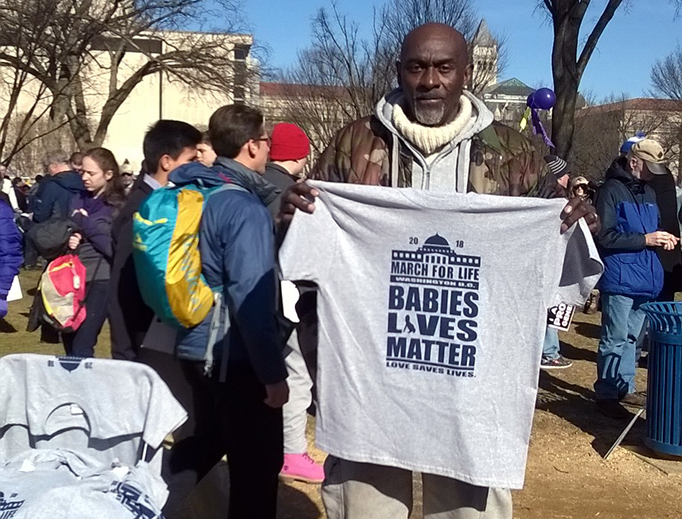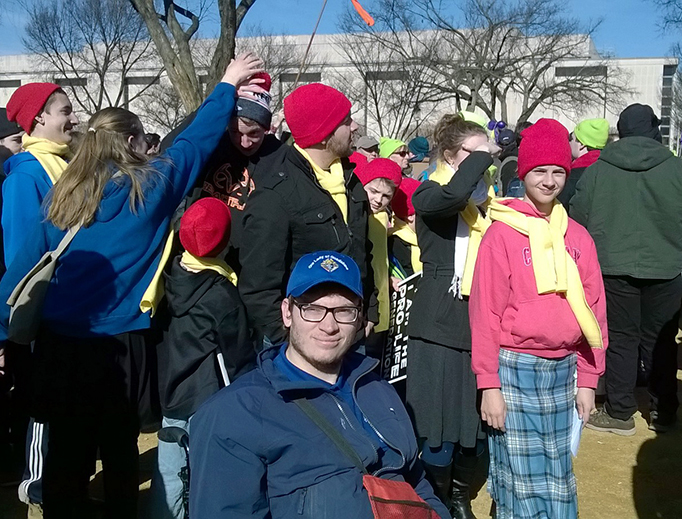Take Heart — The March for Life is Worth It
The March for Life has always been about suffering for the sake of those who suffer, mortifying our softness and making reparation.

I did the March for Life once in 1985. A freshman at a college where I lasted only a year, I was guilted into it. We were given the option of going, but those of us who didn’t wish to go were forced to watch a movie about aborted babies. The movie worked its horror on me and spurred me to action. It was a packed 10-hour all-night bus ride. We arrived irritable, tired, hungry and freezing. We marched. We chanted, “Hey hey, ho, ho, Roe v. Wade has got to go!” We visited our representatives at the Capitol. President Reagan spoke encouragingly to us over a PA system from the White House. Then we slogged back to school, exhausted but with a sense of accomplishment. We had stood up; we had been counted; we had shown them!
But Roe v. Wade marched on. Our marching did not stop it; our representatives did not stop it; Reagan’s encouraging words did not stop it.
Each year that followed brought less and less media coverage of the March. ABC’s Peter Jennings curled his lip and announced that the anti-abortionists were at it – again. Accompanying this twenty-second coverage was perhaps a still photo taken from a sparse section of the crowd. Estimated numbers were never reported as high as we were sure they were.
One year, the other side held its own March. It was on a Sunday in April 1989. It was a celebrity gala event at which Morgan Fairchild arrived wearing rhinestone studded shoes worth thousands of dollars — so Norma McCorvey, a cleaning woman at the time, later remarked. Cherry blossoms rained petals gently down in the spring breeze. Estimated numbers were reported at 600,000.
Then someone from our side had the thought: maybe if we stage a prolife demonstration – not in the dead of winter, not in the middle of the week when people are working or at school, but on a weekend, during cherry blossom season, we could get a piece of those numbers. It was called the Rally for Life and it was April 28, 1991, a Sunday in more ways than one. It was sunny and warm, a picnic more than a march. I remember it perfectly because I showed up – along with my husband, our first baby and 700,000 other people, according to the National Parks Service. (The New York Times reported 200,000.) We had a great time catching up with friends and lounging on the mall. This, I thought, is how it’s done.
I mentioned this to my friend, Lorraine, an older woman with an Italian temper. She was not impressed. “Nellie Gray is out there year after year no matter what the weather!” she hollered. I thought she was jealous that somebody had come along and upped Nellie’s game.
Would this be the end of the March for Life as we knew it? Nope. The March marched on. And seeing as it was always in the dead of winter, on a weekday when my husband was working, during my childbearing years, I didn’t march with it. I did get involved with local prolife work, but the March for Life – was it worth it? Did anybody really care if we showed up? What would one more person in the throng be when the media would likely take the numbers down a third, if they bothered to mention the March at all?
As our children grew, one by one they went on the March. I was glad they were going because they represented me and each one of the years that I stayed home from the March. If two of them went one year, that was two of me, almost as if I’d gone myself for two years. There was one year when the snow was so bad that our church bus and the girls’ college bus were both canceled, but one of our daughters grabbed a seat on another church bus and another one up at college drove down with a few brave friends. They stopped and slept here on the way. I felt almost heroic that year. Almost.
Last year something changed. Women in vulgar hats marched against the new administration; Madonna fantasized about blowing up the White House; Peter Jennings’s successor, ABC’s David Muir, asked Trump if he had heard the women’s voices and marked their great numbers. Trump replied by asking Muir if he was aware of the March for Life to take place in mere days and if he marked the great numbers of prolifers who would be there. He told Muir he himself didn’t realize it, then chided the press for not covering it.
That did it. I went. Finally, people were watching. People were counting. People cared. That’s why people go to marches, right? To be seen. To be heard. To be counted. I would go and be counted along with Vice President Pence, Representative Mia Love and presidential adviser Kellyanne Conway. For the first time in a long time, I reasoned then, going would make a difference.
The March was there waiting for me. Nellie Gray was gone. Her stooped unglamorous figure muffled in thick hat and scarf bravely holding forth year after year like John the Baptist crying in the wilderness: “Repent, do justice, love mercy!” was no more. But others had taken her place. They had counted the March worth saving, worth the trouble. Because of them, not because of me, the March was waiting for me. But for them and our daughters and hundreds of thousands of others there would be no March, for me to return to. No consolidated show of mourning for our national murdering of the helpless and violent sundering of the sacred bond between mother and child. There would be no response to a national crime that demanded a national response, whether the powers that be paid attention or not. Because of them the March saw a day when the powers that be were finally paying attention.
I understand what Lorraine was getting at now. Nellie Gray was there, year after year, in all kinds of weather. It was never just about numbers and fair media coverage. It was about suffering for the sake of those who suffer. Responding in kind. Mortifying our softness. Making reparation.
I am going to accompany our younger kids, or rather to lead them, whether anyone is watching or not.















